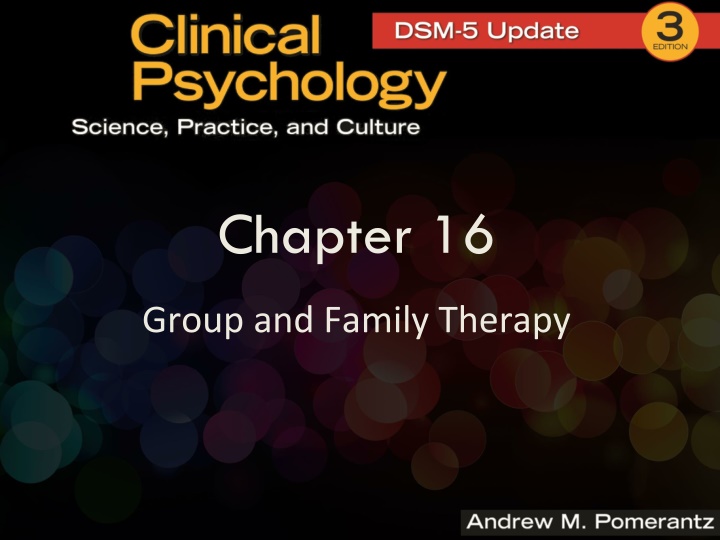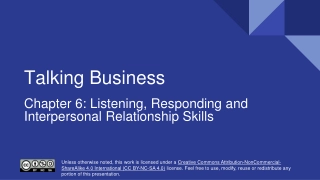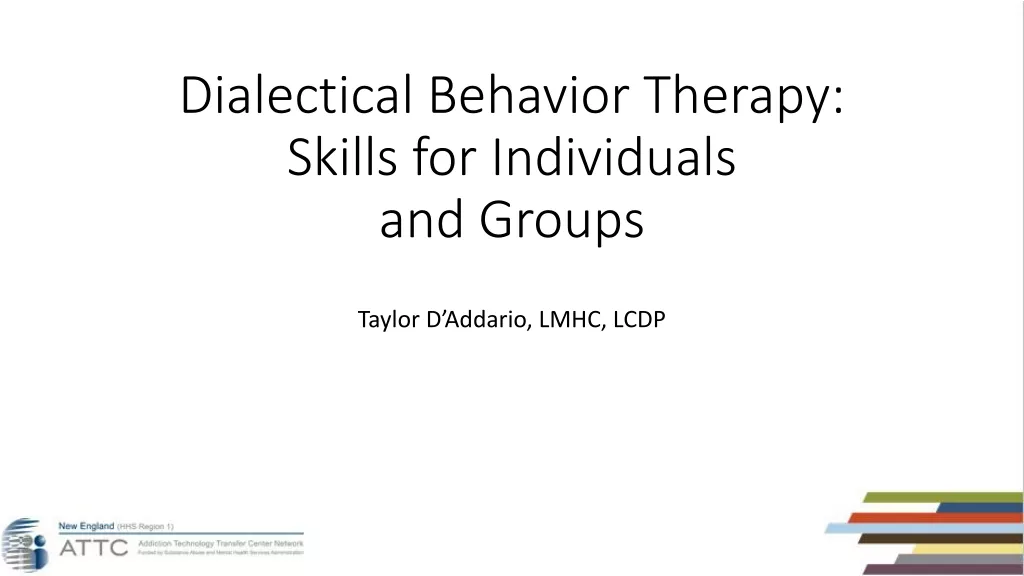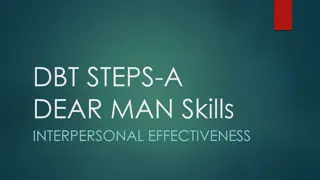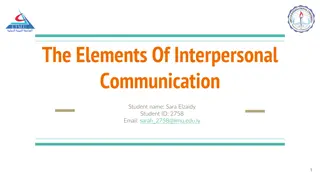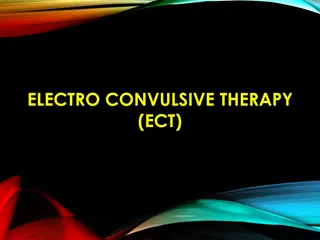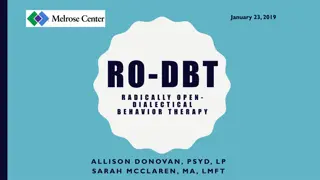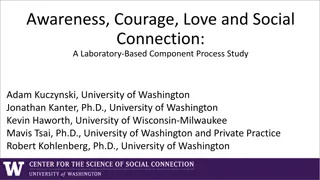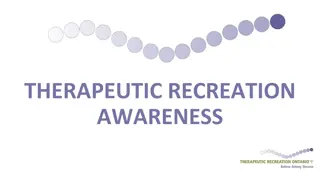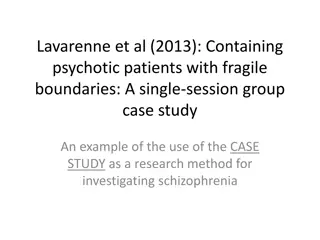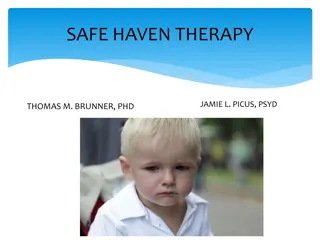Therapeutic Factors in Group Therapy: Enhancing Interpersonal Relationships
Explore the therapeutic factors in group therapy that focus on enhancing interpersonal relationships, instilling hope, promoting universality, and fostering group cohesiveness. Through interactions with fellow group members, clients can improve their interpersonal skills and generalize lessons learned to outside relationships. The group becomes a social microcosm where clients can work on developing trust, acceptance, and belongingness.
Download Presentation

Please find below an Image/Link to download the presentation.
The content on the website is provided AS IS for your information and personal use only. It may not be sold, licensed, or shared on other websites without obtaining consent from the author.If you encounter any issues during the download, it is possible that the publisher has removed the file from their server.
You are allowed to download the files provided on this website for personal or commercial use, subject to the condition that they are used lawfully. All files are the property of their respective owners.
The content on the website is provided AS IS for your information and personal use only. It may not be sold, licensed, or shared on other websites without obtaining consent from the author.
E N D
Presentation Transcript
Chapter 16 Group and Family Therapy
Group and Family Therapy Group therapy and family therapy both feature multiple clients being treated together However, they are quite distinct from each other, with separate histories and methods We will consider them separately in this chapter
Group Therapy: An Interpersonal Emphasis Most forms of group therapy strongly emphasize interpersonal interaction Take advantage of the fact that the group therapy experience itself is based on interacting with other people Irvin Yalom is a leader in this interpersonal approach to group therapy Clients problems stem from flawed interpersonal relationship skills If they can practice and improve on this with fellow group members, they can generalize lessons learned
Therapeutic Factors in Group Therapy Instillation of hope Universality* Imparting information Altruism Corrective recapitulation of the primary family group Development of socializing techniques Imitative behavior Interpersonal learning* Group cohesiveness* Catharsis Existential factors
Therapeutic Factors in Group Therapy (cont.) Universality Clients realize that others share the same struggles (i.e., We re all in the same boat ) Especially powerful in homogeneous groups Group Cohesiveness Feelings of interconnectedness among group members Trust, acceptance, belongingness Analogous to therapeutic alliance in individual therapy
Therapeutic Factors in Group Therapy (cont.) Interpersonal Learning The same interpersonal tendencies that contributed to the client s problems will appear in the group context Group members form relationships with each other and work to improve them, and those improvements will help with outside relationships eventually
Therapeutic Factors in Group Therapy (cont.) Interpersonal Learning (cont.) The group becomes a social microcosm for each client Clients enact their own relationship pathology (without knowing it) in the group itself Focus on the here-and-now Discourage discussion of lives outside of therapy Encourage discussion of relationships between group members in the current moment Clients talk directly with each other about the way they behave toward each other
Practical Issues in Group Therapy Group membership Typically 5-10 clients Open-enrollment groups individuals leave or join at any time Closed-enrollment groups members start and finish together Most individuals can be included, unless they can t interact meaningfully with others and reflect upon that interaction Psychosis, acute crisis, frequent absences are problematic
Practical Issues in Group Therapy (cont.) Preparing clients for group therapy Correct misconceptions Provide realistic and encouraging data about outcome Encourage helpful ways of participating
Practical Issues in Group Therapy (cont.) Developmental Stages of Therapy Groups Initially, cautious and concerned about acceptance Next, some jockeying for position in the social pecking order Finally, cohesiveness emerges
Practical Issues in Group Therapy (cont.) Cotherapists Often, group therapy is conducted by a team of two therapists (rather than one) Second set of eyes and ears can attend to client behaviors Also, therapists can model healthy interaction Cotherapy can be problematic when therapists are competitive, distrustful, or have incompatible therapy orientations
Practical Issues in Group Therapy (cont.) Socializing between clients Extra-group socializing between clients (romantic or platonic) is a significant problem Even when prohibited at the outset, it happens at times Loyalty to friendship may exceed loyalty to group Other group members can feel excluded
Ethical Issues in Group Therapy Confidentiality Clients should maintain confidentiality of fellow members, but difficult to enforce Consequences of broken confidentiality can effect professional or personal life, as well as group climate of trust Important to get group members to appreciate importance of this and commit to maintaining confidentiality at outset
How Well Does Group Therapy Work? Not studied as extensively as individual therapy Existing studies strongly suggest that group therapy is beneficial About equal to individual therapy in most studies; slightly inferior in a few studies Cohesiveness in group is a major contributor to successful outcome Can be less expensive than individual therapy also
Family Therapy: The System as the Problem When the family therapy movement initially arose in the mid-1900s, it was considered revolutionary Psychological symptoms as a byproduct of dysfunctional families One individual may exhibit symptoms, but the problem belongs to the entire system
Family Therapy: The System as the Problem (cont.) Circular causality events influence each other reciprocally As opposed to linear causality, which is endorsed by individual therapists Focus on communication patterns in families Focus on functionalism of symptoms Within family, symptoms may be adaptive
Family Therapy: The System as the Problem (cont.) Homeostasis Families regulate themselves by returning themselves to an emotional set point Like a thermostat A family member may sense that the family is reaching an uncomfortable state, and take action (feedback) to return it to comfort zone
Assessment of Families Interviews and other methods as used in individual therapy are common Ask who the family includes Genograms A pencil-and-paper method of creating a family tree that incorporates detailed information about the relationships between family members for at least three generations Process and result can both be beneficial
Assessment of Families (cont.) Family Life Cycle A developmental theory for families, including seven stages Leaving home Joining of families through marriage or union Families with young children Families with adolescents Launching children and moving on in midlife Families in late middle age Families nearing the end of life
Assessment of Families (cont.) Conflict Tactics Scale (CTS) Objective questionnaire used to assess violence and abuse in couples Measures how individuals react when family conflicts arise Speaking calmly, using insults, throwing objects, hitting others, etc.
Assessment of Families (cont.) Identified patient It can be critical for the family therapist to persuade the family that the problem is systemic rather than individual This can be difficult when the family has attributed the problem entirely to one member (identified patient)
Family Therapy: Essential Classic Concepts Family Structure Unwritten rules by which a family operates When flawed, problems in relationships and individuals may result Family structure can be improved by focusing on subsystems within families and the boundaries between them Should be neither enmeshed nor disengaged
Family Therapy: Essential Classic Concepts (cont.) Differentiation of Self An appropriate degree of self-determination, or becoming your own person, is essential Families that don t allow this to happen can create problems for their members Families remain emotionally fused, or an undifferentiated ego mass
Family Therapy: Essential Classic Concepts (cont.) Triangles When two people are in conflict, either one may try to bring in a third person to take their side In families, this can be problematic, especially when the triangulated person is a child Therapeutic goal is to encourage detriangulation and direct communication between two people at odds with each other
Family Therapy: Contemporary Approaches Solution-Focused Therapy Evolved from strategic family therapy Emphasis on solving problems Emphasis on the use of solution-talk rather than problem-talk Make clients think about positive outcomes rather than unpleasant present situations Emphasis on exceptions to current problems (times when better) and how they created these exceptions (to encourage them to create more exceptions)
Family Therapy: Contemporary Approaches (cont.) Narrative Therapy Highlights clients tendencies to create meanings about themselves and the events in their lives in particular ways Stories we construct about our own lives are powerful influences on the way we experience new events We edit our experiences to fit the story line Revise stories and recast selves in more positive, heroic way; new events can be interpreted more positively
Ethical Issues in Family Therapy Cultural competence Family therapists should appreciate the cultural background of the families Ethnicity Religion Other variables Often, one family includes a blend of cultural influences Members from different cultures Varying levels of acculturation
Ethical Issues in Family Therapy (cont.) Confidentiality Can be difficult when one family member tells therapist something in private Diagnostic Accuracy DSM disorders apply to individuals, not families If diagnosis is required, therapist who thinks system is flawed has a dilemma Labeling identified patient with disorder can perpetuate the family s tendency to blame one member
How Well Does Family Therapy Work? Methodological difficulties in measuring outcome of family therapy include the issue of which family members opinions should be solicited Not as much outcome research as individual therapy, but existing research is very positive Family therapy appears to work about as well as other modes of therapy Empirical studies demonstrate that a strong therapeutic relationship is key
